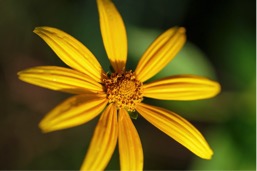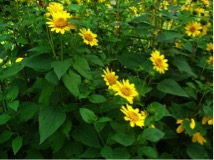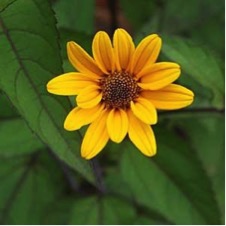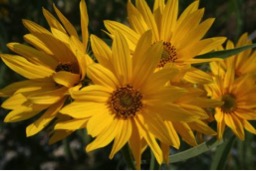Native sunflowers are essential for native plant gardens because they have high wildlife value. They are a caterpillar host plant for 71 species of butterflies and moths. Imagine all the wildlife you will see when you add these amazing natives to your garden! But be forewarned—they are not deer proof. Still, sunflowers are definitely worth having in your garden. Just protect them from marauding deer.
Most sunflowers are perennials. They vary in height, flowers, leaf shapes and growing conditions, so be sure to choose the right one for your garden.
Native sunflower species in the greater Media area:
- ashy sunflower (Helianthus mollis)
- giant sunflower (Helianthus giganteus)
- paleleaf woodland sunflower (Helianthus strumosus)
- sawtooth sunflower (Helianthus grosseserratus)
- thinleaf sunflower (Helianthus decapetalus)
- woodland sunflower (Helianthus divaricatus)
Thinleaf sunflower (Helianthus decapetalus)
Thinleaf sunflower is a perennial that provides food for pollinators, birds and mammals. The bright yellow flowers are up to 3 inches across and bloom from July to Oct. That’s a lot of bloom time!
Thinleaf prefers full sun to partial shade in moist, loamy, well-drained soils. Use this plant in a woodland edge or meadow. It’s great for naturalizing, but it can spread aggressively in the right conditions. If you choose this plant, you will need room for it to roam.
Woodland sunflower (Helianthus divaricatus)
Woodland sunflower is a perennial with large, yellow flowers that bloom from early summer into early fall. The leaves are smooth with a slightly toothed margin and hairy underside. It may need to be staked, because it can grow 5 to 7 feet tall.
Woodland Sunflower is easy to grow in average well-drained soils in partial shade. It is tolerant of a wide range of soil types and is drought tolerant once established. It can be used in the native/pollinator garden, naturalized area or woodland garden.
Giant Sunflower (Helianthus giganteus)
If you love big sunflowers, here’s the one for you. Giant sunflower grows up to 9′ tall. If that’s not tall enough for you, grow it in rich and moist soils, where it can grow up to 13′ tall). It’s a great plant for a sunny rain garden, since it likes wet soil and full sun. Giant sunflower can spread aggressively by rhizomes, so it’s not suitable for a small garden. It’s better for naturalizing in meadows, wetland edges, and stream banks.
Giant sunflower has an interesting central stem that’s reddish purple and covered with white hairs. Leaves are 3-7″ long. Flowers are 3-6″ wide.
Giant sunflower seeds are eaten by many kinds of birds during the fall and winter. It’s a magnet for native bees, honeybees, bumblebees, Syrphid flies, butterflies, and beetles.
Oxeye sunflower (Heliopsis helianthoides)
Oxeye is not actually a sunflower, but it is definitely worth mentioning. It is a sunflower-like, short-lived perennial, Bees and tiny wasps find it appeaing. I have oxeye in my garden and I love it. So did the deer that found a hole in my deer fence. Sigh…
Oxeye is an easy perennial to grow. It likes moist to dry soil, tolerates a wide range of soil conditions, but does best in moist, well-drained soil in full sun. Oxeye thrives in open woodlands, woodland borders, fields, and your garden. Ox-Eye grows 3 to 5 feet tall, so it may need staking. The leaves have a toothed margin and a sandpapery texture. Its yellow flowers with a golden center will delight you and your insects from mid-summer into fall.
Native sunflowers, essential to the native plant garden due to their high wildlife value, are one of the keystone native plants. Be sure to add sunflowers to your must have list.





Leave a Reply